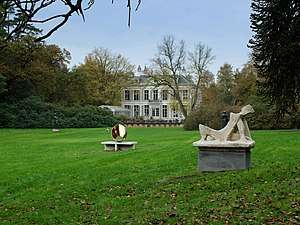Middelheim Open Air Sculpture Museum
Middelheim Open Air Sculpture Museum (Dutch Beeldentuin Middelheim Museum) is a sculpture park of 30 acres in the park part of the Middelheim Nachtegalen Park at Antwerp.

History
In 1342, Middelheim is mentioned as a stede geheten Middelheim. Since the 16th century, it was used as a summer residence for rich merchants from Antwerp. In the 18th century, Pierre François Gisbert van Schorel, Lord of Wilrijk brought an important art collection in the castle featuring notable artworks from Rubens and Van Dyck among others.
Then, the estate was ceded to the Knight Parthon de Von where he wrote the Fables and dedicated himself to horticulture. In 1842, it was sold to the Le Grelle family, which sold it to the Antwerp municipality in 1910.
Overview
The Middelheimmuseum park is known for its sculpture, which arose from the 'Biennale Middelheim', which was held in the park every two years since 1951.[1] After twenty episodes of this sculpture exhibition in 1989 they decided to choose another way to supplement the image collection. The layout of the sculpture park has the shape of four fluttering strips on both sides of the Middelheimlaan, that cuts through the middle of the park.
The collection comprises two hundred images, including several dozen installed in the city of Antwerp. In addition, the Open Air Museum has hundreds of sculptures which are displayed through temporary exhibitions in the Braem Pavilion. In this pavilion fragile pieces are lined up that can not be place outdoors. The Burgemeester Lode Craeybeckx documentation centre of the sculpture park is located in the Orangerie of the Middelheimpark.
In 2012, the botanical garden Hortiflora with an area of 5 hectares was added to the existing sculpture park. This creates a natural connection to the Nachtegalen Park. On the side of the Hortiflora the architect Paul Robbrecht designed a new half open exhibition building called The House. This is a five meter high transparent semi volume with a clear geometry. In his own words the designer sees the building as an intimate building, populated with temporary residents. It wants to be a space that nurtures and protects. Not oversized, like most contemporary museums but on a human scale: A pavilion that makes possible a temporary one-to-one relationship with art. The planner has also outlined new lines into the existing landscape.
Collection
The collection includes works by many leading sculptors of modern and contemporary visual art, among others:
- Ai Weiwei (The Bridge Without a Name)
- Carl Andre (74 Weathering Way)
- Mari Andriessen (Bomb victim from 1948/51)
- Hans Arp (Scales Tree, 1947–54)
- Rudolf Belling (Dreiklang, 1919)
- Wander Bertoni (Icarus, 1953)
- Joseph Bernard (Dancing woman and child, 1925)
- Max Bill (Endless winding, 1953–56)
- Stig Blomberg (Bathing children, 1935)
- Emile-Antoine Bourdelle (The unruly ram, 1909; Heracles Archer, 1909; Dr. Koeberle, 1914)
- Chris Burden (Beam Drop Middelheimmuseum from 2009)
- Guillaume Bijl (Roman Street from 1994)
- Alexander Calder (The Dog, 1958)
- Agustín Cárdenas (L, 1968)
- Tony Cragg (Envelope)
- Eugène Dodeigne (Kneeling Figure, 1970; Three single people, 1978)
- Arthur Dupon (Torso from 1925)
- Jan Fabre (Installation architectural work with guided trees)
- Luciano Fabro (Bagnati)
- Pericle Fazzini (Sibilla, 1947)
- Pablo Gargallo (The Prophet, 1933)
- Emile Gilioli (In Heaven from 1954/55)
- Dan Graham (Belgian Fun, 2004)
- George Grard (Niobe from 1947/48)
- Karl Hartung (Composition II, 1949)
- Bernhard Heiliger (In relation standing figures, 1954)
- Barbara Hepworth (Cantate Domino, 1958)
- Floris Jespers (Black Women Group, 1953)
- Oscar Jespers (Birth, 1932)
- Phillip King (Bali, 1977)
- Per Kirkeby (Brick Sculpture)
- Georg Kolbe (Large sitting from 1929)
- Hildo Krop (Urge to life from 1949/51)
- Jef Lambeaux (Wrestlers from 1895)
- Henri Laurens (Océanide, 1933)
- Mark Macken (April, 1957)
- Aristide Maillol (River from 1939/43)
- Giacomo Manzù (The dance step, 1950, and Cardinal, 1952)
- Marcel Martí
- Arturo Martini (Invernali, 1931, Chiaro di luna 1932 and Giochi invernali)
- Marcello Mascherini (St. Francis, 1957)
- Bernard Meadows (Pointing figure with a child from 1966)
- Constantin Meunier ( The Sower from 1896 and the bump carrier in 1898)
- George Minne (Mans Torso from 1910)
- Yasuo Mizui (White Flame from 1975).
- Henry Moore (King and Queen, 1952–53)
- Louise Nevelson (Sun Disk / Moonshadow V, 1976)
- François Pompon (Polar Bear, 1920)
- Germaine Richier (The Mantis (Mantis), 1946)
- Auguste Rodin (Balzac in 1892, Bronze Age from 1880, John the Baptist from 1880)
- Bernard Rosenthal (Odyssey I, 1967)
- Roman Signer (Installation Ski anticipation of a container shaped volume)
- Olivier Strebelle (Fountain, 1951)
- Albert Szukalski (Dialog, 1974)
- Jesús Rafael Soto (Double progression vert et blanc , 1969)
- Timm Ulrichs (Modelhäuser, type Bomarzo, 2001)
- Hilde Van Sumere (Movement II, 1974-1976)
- Alberto Viani (Female Torso from 1954)
- Lawrence Weiner
- Franz West
- Andre Willequet
- Rik Wouters (The Mad Maiden from 1912, Homely care from 1913)
- Ossip Zadkine (The Phoenix from 1944).
Gallery
 Bridge by Ai Weiwei
Bridge by Ai Weiwei Baigneurs by Luciano Fabro, 1994
Baigneurs by Luciano Fabro, 1994.jpg) White Flame by
White Flame by
Yasuo Mizui, 1975
References
- Openluchtmuseum voor Beeldhouwkunst Middelheim (Antwerp, Belgium) (1969) 10e Biennale Middelheim Antwerpen. p. 13